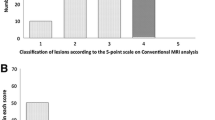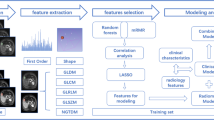Abstract
Purpose
To assess qualitative and quantitative analysis of gadoxetate disodium-enhanced hepatobiliary phase MR imaging (MRI) and assess the performance of classification and regression tree analysis for the differentiation of focal nodular hyperplasia (FNH) and hepatocellular adenoma (HCA).
Materials and methods
This retrospective study was approved by our local ethics committee. One hundred seventy patients suspected of having FNH or HCA underwent gadoxetate disodium-enhanced MRI. The reference standard was either pathology or follow-up imaging. Two readers reviewed images to identify qualitative imaging features and measure signal intensity on unenhanced, dynamic, and hepatobiliary phase images. For quantitative analysis, contrast enhancement ratio (CER), lesion-to-liver contrast (LLC), signal intensity ratio (SIR), and relative signal enhancement ratio (RSER) were calculated. A classification and regression tree (CART) analysis was developed.
Results
Eighty-five patients met the inclusion criteria, with a total of 97 FNHs and 43 HCAs. For qualitative analysis, the T1 signal intensity on the hepatobiliary phase provided the highest overall classification performance (91.9% sensitivity, 90.1% specificity, and 90.9% accuracy). For quantitative analysis, RSER in the hepatobiliary phase with a threshold of 0.723 provided the highest classification performance (92.6% sensitivity and 89.4% specificity) to differentiate FNHs from HCAs. A CART model based on five qualitative imaging features provided an accuracy of 94.4% (95% confidence interval 90.0–98.9%).
Conclusion
Gadoxetate disodium-enhanced hepatobiliary phase provides high diagnostic performance as demonstrated in quantitative and qualitative analysis in differentiation of FNH and HCA, supported by a CART decision model.
Graphical abstract





Similar content being viewed by others
Abbreviations
- CART:
-
Classification and regression tree
- CE:
-
Contrast enhanced
- CER:
-
Contrast enhancement ratio
- FNH:
-
Focal nodular hyperplasia
- HBP:
-
Hepatobiliary phase
- HCA:
-
Hepatocellular adenoma
- LLC:
-
Lesion-to-liver contrast
- NPV:
-
Negative predictive value
- PPV:
-
Positive predictive value
- ROI:
-
Region of interest
- RSER:
-
Relative signal enhancement ratio
- SI:
-
Signal intensity
- SIR:
-
Signal intensity ratio
References
Marrero JA, Ahn J, Rajender Reddy K. ACG clinical guideline: the diagnosis and management of focal liver lesions. Am J Gastroenterol 2014;109(9):1328-1347; quiz 1348. https://doi.org/10.1038/ajg.2014.213
Vilgrain V, Uzan F, Brancatelli G, Federle MP, Zappa M, Menu Y. Prevalence of Hepatic Hemangioma in Patients with Focal Nodular Hyperplasia: MR Imaging Analysis. Radiology 2003;229(1):75-79. https://doi.org/10.1148/radiol.2291021284
Maillette de Buy Wenniger L, Terpstra V, Beuers U. Focal Nodular Hyperplasia and Hepatic Adenoma: Epidemiology and Pathology. Digestive Surgery 2010;27(1):24-31. https://doi.org/10.1159/000268404
Grazioli L, Bondioni MP, Haradome H, Motosugi U, Tinti R, Frittoli B, Gambarini S, Donato F, Colagrande S. Hepatocellular adenoma and focal nodular hyperplasia: value of gadoxetic acid-enhanced MR imaging in differential diagnosis. Radiology 2012;262(2):520-529. https://doi.org/10.1148/radiol.11101742
Bieze M, van den Esschert JW, Nio CY, Verheij J, Reitsma JB, Terpstra V, van Gulik TM, Phoa SSKS. Diagnostic Accuracy of MRI in Differentiating Hepatocellular Adenoma From Focal Nodular Hyperplasia: Prospective Study of the Additional Value of Gadoxetate Disodium. American Journal of Roentgenology 2012;199(1):26-34. https://doi.org/10.2214/ajr.11.7750
McInnes MD, Hibbert RM, Inácio JR, Schieda N. Focal Nodular Hyperplasia and Hepatocellular Adenoma: Accuracy of Gadoxetic Acid-enhanced MR Imaging—A Systematic Review. Radiology 2015;277(2):413-423. https://doi.org/10.1148/radiol.2015142986
Kuo Y-H, Wang J-H, Lu S-N, Hung C-H, Wei Y-C, Hu T-H, Chen C-H, Yen Y-H, Lee C-M, Eng H-L. Natural course of hepatic focal nodular hyperplasia: A long-term follow-up study with sonography. Journal of Clinical Ultrasound 2009;37(3):132-137. https://doi.org/10.1002/jcu.20533
Deneve JL, Pawlik TM, Cunningham S, Clary B, Reddy S, Scoggins CR, Martin RC, D'Angelica M, Staley CA, Choti MA, Jarnagin WR, Schulick RD, Kooby DA. Liver cell adenoma: a multicenter analysis of risk factors for rupture and malignancy. Ann Surg Oncol 2009;16(3):640-648. https://doi.org/10.1245/s10434-008-0275-6
Farges O, Dokmak S. Malignant transformation of liver adenoma: an analysis of the literature. Dig Surg 2010;27(1):32-38. https://doi.org/10.1159/000268405
Grazioli L, Bondioni MP, Haradome H, Motosugi U, Tinti R, Frittoli B, Gambarini S, Donato F, Colagrande S. Hepatocellular Adenoma and Focal Nodular Hyperplasia: Value of Gadoxetic Acid–enhanced MR Imaging in Differential Diagnosis. Radiology 2012;262(2):520-529. https://doi.org/10.1148/radiol.11101742
Auer TA, Walter-Rittel T, Geisel D, Schöning W, Schmelzle M, Müller T, Sinn B, Denecke T, Hamm B, Fehrenbach U. HBP-enhancing hepatocellular adenomas and how to discriminate them from FNH in Gd-EOB MRI. BMC Med Imaging 2021;21(1):28. https://doi.org/10.1186/s12880-021-00552-0
Aalten SMv, Thomeer MGJ, Terkivatan T, Dwarkasing RS, Verheij J, Man RAd, IJzermans JNM. Hepatocellular Adenomas: Correlation of MR Imaging Findings with Pathologic Subtype Classification. Radiology 2011;261(1):172-181. https://doi.org/10.1148/radiol.11110023
Tse JR, Naini BV, Lu DSK, Raman SS. Qualitative and Quantitative Gadoxetic Acid–enhanced MR Imaging Helps Subtype Hepatocellular Adenomas. Radiology 2016;279(1):118-127. https://doi.org/10.1148/radiol.2015142449
Landis JR, Koch GG. An application of hierarchical kappa-type statistics in the assessment of majority agreement among multiple observers. Biometrics 1977;33(2):363-374.
Breiman L, Friedman JH, Olshen RA, Stone CJ. Classification And Regression Trees. (New York, Routledge, 1984).
Ngu S, Lebron-Zapata L, Pomeranz C, Katz S, Gerst S, Zheng J, Moskowitz C, Do RK. Inter-observer agreement on the assessment of relative liver lesion signal intensity on hepatobiliary phase imaging with gadoxetate (Gd-EOB-DTPA). Abdom Radiol (NY) 2016;41(1):50-55. https://doi.org/10.1007/s00261-015-0609-3
Ronot M, Bahrami S, Calderaro J, Valla DC, Bedossa P, Belghiti J, Vilgrain V, Paradis V. Hepatocellular adenomas: accuracy of magnetic resonance imaging and liver biopsy in subtype classification. Hepatology 2011;53(4):1182-1191. https://doi.org/10.1002/hep.24147
Grieser C, Steffen IG, Kramme IB, Blaker H, Kilic E, Perez Fernandez CM, Seehofer D, Schott E, Hamm B, Denecke T. Gadoxetic acid enhanced MRI for differentiation of FNH and HCA: a single centre experience. Eur Radiol 2014;24(6):1339-1348. https://doi.org/10.1007/s00330-014-3144-7
Grazioli L, Federle MP, Brancatelli G, Ichikawa T, Olivetti L, Blachar A. Hepatic adenomas: imaging and pathologic findings. Radiographics 2001;21(4):877-892; discussion 892-874. https://doi.org/10.1148/radiographics.21.4.g01jl04877
Suh CH, Kim KW, Kim GY, Shin YM, Kim PN, Park SH. The diagnostic value of Gd-EOB-DTPA-MRI for the diagnosis of focal nodular hyperplasia: a systematic review and meta-analysis. Eur Radiol 2015;25(4):950-960. https://doi.org/10.1007/s00330-014-3499-9
Vander Borght S, Libbrecht L, Blokzijl H, Faber KN, Moshage H, Aerts R, Van Steenbergen W, Jansen PL, Desmet VJ, Roskams TA. Diagnostic and pathogenetic implications of the expression of hepatic transporters in focal lesions occurring in normal liver. J Pathol 2005;207(4):471-482. https://doi.org/10.1002/path.1852
Kitao A, Zen Y, Matsui O, Gabata T, Kobayashi S, Koda W, Kozaka K, Yoneda N, Yamashita T, Kaneko S, Nakanuma Y. Hepatocellular carcinoma: signal intensity at gadoxetic acid-enhanced MR Imaging—correlation with molecular transporters and histopathologic features. Radiology 2010;256(3):817-826. https://doi.org/10.1148/radiol.10092214
van Kessel CS, de Boer E, ten Kate FJ, Brosens LA, Veldhuis WB, van Leeuwen MS. Focal nodular hyperplasia: hepatobiliary enhancement patterns on gadoxetic-acid contrast-enhanced MRI. Abdom Imaging 2013;38(3):490-501. https://doi.org/10.1007/s00261-012-9916-0
Haimerl M, Wächtler M, Zeman F, Verloh N, Platzek I, Schreyer AG, Stroszczynski C, Wiggermann P. Quantitative evaluation of enhancement patterns in focal solid liver lesions with Gd-EOB-DTPA-enhanced MRI. PLoS ONE 2014;9(6):e100315. https://doi.org/10.1371/journal.pone.0100315
Acknowledgements
King Saud Medical City scholarship to Talal M Alamri. King Fahad Medical City scholarship to Mohammad Al Shaikh. Fonds de recherche du Québec en Santé (FRQ-S) and Fondation de l'association des radiologistes du Québec (FARQ) Clinical Research Scholarship—Senior Salary Award (FRQS-ARQ #298509o) to An Tang.
Author information
Authors and Affiliations
Corresponding author
Ethics declarations
Conflict of interest
Talal M. Al-Amri, Milena Cerny, Mohammad Al Shaikh, Jean-Sébastien Billiard, Damien Olivié, Miguel Chagnon, and An Tang declare that they have no financial conflict of interest.
Ethical approval
All procedures performed in studies involving human participants were in accordance with the ethical standards of the institutional and/or national research committee and with the 1964 Helsinki declaration and its later amendments or comparable ethical standards.
Informed consent
Informed consent was waived from all individual participants included in the study.
Additional information
Publisher's Note
Springer Nature remains neutral with regard to jurisdictional claims in published maps and institutional affiliations.
Rights and permissions
Springer Nature or its licensor (e.g. a society or other partner) holds exclusive rights to this article under a publishing agreement with the author(s) or other rightsholder(s); author self-archiving of the accepted manuscript version of this article is solely governed by the terms of such publishing agreement and applicable law.
About this article
Cite this article
Alamri, T.M., Cerny, M., Al Shaikh, M. et al. Differentiation of focal nodular hyperplasia and hepatocellular adenoma using qualitative and quantitative imaging features and classification and regression tree analysis. Abdom Radiol 48, 874–885 (2023). https://doi.org/10.1007/s00261-022-03766-0
Received:
Revised:
Accepted:
Published:
Issue Date:
DOI: https://doi.org/10.1007/s00261-022-03766-0




